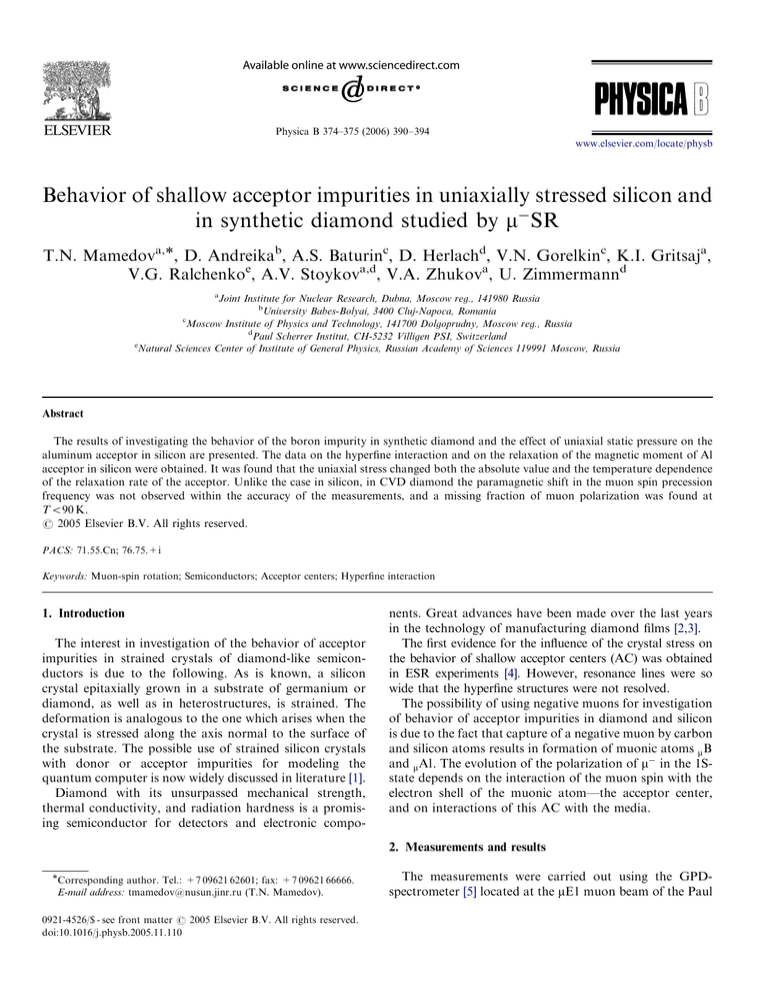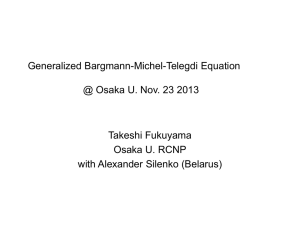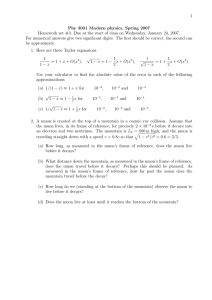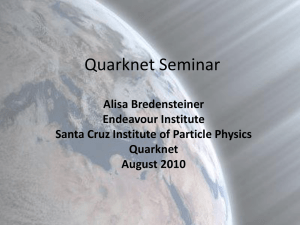
ARTICLE IN PRESS
Physica B 374–375 (2006) 390–394
www.elsevier.com/locate/physb
Behavior of shallow acceptor impurities in uniaxially stressed silicon and
in synthetic diamond studied by mSR
T.N. Mamedova,, D. Andreikab, A.S. Baturinc, D. Herlachd, V.N. Gorelkinc, K.I. Gritsaja,
V.G. Ralchenkoe, A.V. Stoykova,d, V.A. Zhukova, U. Zimmermannd
a
Joint Institute for Nuclear Research, Dubna, Moscow reg., 141980 Russia
b
University Babes-Bolyai, 3400 Cluj-Napoca, Romania
c
Moscow Institute of Physics and Technology, 141700 Dolgoprudny, Moscow reg., Russia
d
Paul Scherrer Institut, CH-5232 Villigen PSI, Switzerland
e
Natural Sciences Center of Institute of General Physics, Russian Academy of Sciences 119991 Moscow, Russia
Abstract
The results of investigating the behavior of the boron impurity in synthetic diamond and the effect of uniaxial static pressure on the
aluminum acceptor in silicon are presented. The data on the hyperfine interaction and on the relaxation of the magnetic moment of Al
acceptor in silicon were obtained. It was found that the uniaxial stress changed both the absolute value and the temperature dependence
of the relaxation rate of the acceptor. Unlike the case in silicon, in CVD diamond the paramagnetic shift in the muon spin precession
frequency was not observed within the accuracy of the measurements, and a missing fraction of muon polarization was found at
To90 K.
r 2005 Elsevier B.V. All rights reserved.
PACS: 71.55.Cn; 76.75.+i
Keywords: Muon-spin rotation; Semiconductors; Acceptor centers; Hyperfine interaction
1. Introduction
The interest in investigation of the behavior of acceptor
impurities in strained crystals of diamond-like semiconductors is due to the following. As is known, a silicon
crystal epitaxially grown in a substrate of germanium or
diamond, as well as in heterostructures, is strained. The
deformation is analogous to the one which arises when the
crystal is stressed along the axis normal to the surface of
the substrate. The possible use of strained silicon crystals
with donor or acceptor impurities for modeling the
quantum computer is now widely discussed in literature [1].
Diamond with its unsurpassed mechanical strength,
thermal conductivity, and radiation hardness is a promising semiconductor for detectors and electronic compo-
nents. Great advances have been made over the last years
in the technology of manufacturing diamond films [2,3].
The first evidence for the influence of the crystal stress on
the behavior of shallow acceptor centers (AC) was obtained
in ESR experiments [4]. However, resonance lines were so
wide that the hyperfine structures were not resolved.
The possibility of using negative muons for investigation
of behavior of acceptor impurities in diamond and silicon
is due to the fact that capture of a negative muon by carbon
and silicon atoms results in formation of muonic atoms m B
and m Al. The evolution of the polarization of m in the 1Sstate depends on the interaction of the muon spin with the
electron shell of the muonic atom—the acceptor center,
and on interactions of this AC with the media.
2. Measurements and results
Corresponding author. Tel.: +7 09621 62601; fax: +7 09621 66666.
E-mail address: tmamedov@nusun.jinr.ru (T.N. Mamedov).
0921-4526/$ - see front matter r 2005 Elsevier B.V. All rights reserved.
doi:10.1016/j.physb.2005.11.110
The measurements were carried out using the GPDspectrometer [5] located at the mE1 muon beam of the Paul
ARTICLE IN PRESS
T.N. Mamedov et al. / Physica B 374–375 (2006) 390–394
391
The time distribution of m ! e decay electrons was
fitted by the function
P0 lt
NðtÞ ¼ N 0 1 þ
e
cos ðot þ jÞ et=tm ,
(1)
3
(a)
(b)
where N 0 is proportional to the number of muons stopped
in the sample, tm is the life time of the muon in the 1S-state
of the muonic atom, P0 is the muon polarization in the 1Sstate at t ¼ 0, l is the muon spin relaxation rate, o and j
are the frequency and the initial phase of the muon spin
precession in the magnetic field.
Fig. 1 show the results of measurement of temperature
dependences of the relaxation rate l and the frequency shift
Do=o0 of the muon spin precession for the sample Si-2
with the phosphorus concentration 1:9 1013 cm3 (see
also Ref. [8]). The directions of the magnetic field, crystal
axes and muon polarization are shown in the insets in Fig.
1. The frequency shift was defined as difference of the
muon spin precession frequency at temperature T and at
room temperature: Do ¼ oðTÞ o0 .
Application of pressure increases the muon spin relaxation rate and also alters its temperature dependence. In
contrast to the relaxation rate, the shift of the muon spin
precession frequency changes slightly under the pressure.
To obtain more detailed information on the dependence
of the muon spin relaxation rate on external pressure,
Fig. 1. Temperature dependences of the relaxation rate (a) and the
frequency shift (b) of the muon spin precession in the sample Si-2. Closed
circles correspond to the pressure of 1:7 kbar on the sample, open circles
correspond to the absence of pressure. The curves show the results of fits
(see text).
Sherrer Institute. Silicon samples were 4-facet prisms with
the base size of 9:5 9:5 mm2 and height 22 mm. The
samples were oriented so that one of the ½1 1 1, ½1 1 0,
½1 0 0 crystal axes was perpendicular to the prism base
plane with the accuracy of 1 . Two samples (Si-1 and Si2) were cut from Czochralski-grown (Cz) monocrystals and
two samples (Si-3 and Si-4) from a float-zone-grown (FZ)
monocrystal.
The diamond sample of total mass 2 g was a batch of
pieces of several diamond films 0.3–0:7 mm thick and
about of 1 cm2 in lateral size. The diamond films
were produced by a microwave plasma assisted CVD
technique in CH4 =H2 mixtures [6]. The main impurities in
diamond were hydrogen (75–320 ppm) and nitrogen
(0.4–10 ppm). The crystal axis ½1 1 0 perpendicular to the
film plane was predominant grain orientation. The
resistivity of the sample was in the range of 1012 –
1014 Ohm cm.
For uniaxial compress of the silicon crystals a beryllium—bronze pressure cell was constructed [7]. It allowed
one to apply a pressure up to 5 kbar to the sample.
Polarization of negative muons was studied in the magnetic
field of 0:25 T transverse to the muon spin in the
temperature range 5–300 K.
(a)
(b)
Fig. 2. Temperature dependence of the muon spin relaxation rate in the
sample Si-3 for different pressure applied along ½1 0 0.
ARTICLE IN PRESS
392
T.N. Mamedov et al. / Physica B 374–375 (2006) 390–394
measurements with the Si-3 sample were done at different
pressure (see Fig. 2). The directions of the magnetic field
and the stress were the same as in the case of the Si-2
sample. As follows from the data presented in Fig. 2(a), the
relaxation rate of the negative muon spin increases with
increasing pressure. At 2:33 kbar an indication to more
complicated temperature dependence of P0 ðTÞ=P0 ðT ¼
300 KÞ, Do=o0 and lðTÞ (see Fig. 2b) was observed.
The Si-4 sample was investigated
at (a) Hk½0 0 1 and no
pffiffiffi
uniaxialpffiffistress;
(b)
Hk½1
1̄
2
and
no uniaxial stress; (c)
ffi
Hk½1 1̄ 2 and a pressure of 1:34 kbar applied along the
crystal axis ½1 1 0. It was found that the pressure of
1:34 kbar does not affect the muon spin precession
frequency shift.
Complex temperature dependences of the polarization
and the relaxation rate of the negative muon spin were
observed in the CVD-diamond. The muon polarization
increases with the increase of temperature and reaches its
maximum value at 90 K (see Fig. 3). The increase of the
relaxation rate l was observed in the range of To60 K. It
is not excluded that at To60 K the temperature dependence of l may have a complex structure. The experimental
data in the range of 100oTo230 K are well fitted by the
function lT 2:40:15 ; however, at higher temperatures a
deviation from this dependence is evident. A pronounced
difference of the results for diamond from those for silicon
is that in diamond there was no frequency shift of the
muon spin precession within the accuracy of the measurement ðDo=o0 o103 Þ.
3. Discussion
A muonic atom m B ðm AlÞ in the crystal lattice of diamond
(silicon), is analogous to boron (aluminum) acceptor
center. Acceptor centers m B and m Al can be ionized
ðm B1 , m Al1 Þ or neutral ðm B0 , m Al0 Þ. The electron shell of
1
and m Al1 is diamagnetic. In this state the muon spin
mB
precession frequency in a magnetic field is equal to that for
a free muon.
The electron shells of m B0 and m Al0 have nonzero
magnetic moments. The hyperfine interaction between the
muon spin and the AC electron shell is ineffective if the
relaxation rate of the magnetic moment of the electron
shell n is higher than the hyperfine interaction constant
Ahf =h. In this case the muon spin precesses in an external
magnetic field at a frequency o close to that for the free
muon o0 . A difference between o and o0 is due to
polarization of the AC electrons in the magnetic field.
According to [9], at nbAhf =h the analytical relations
between the quantities of the time evolution of the muon
polarization in the 1S-state of the muonic atom and those
describing interactions of the given muonic atom (AC) in
semiconductor are
Do
gm JðJ þ 1ÞAhf
,
¼ Bm
o0
3kB T
2mB
l¼
(a)
(b)
Fig. 3. Temperature dependences of the muon spin polarization and
relaxation rate in diamond. The lines are guides to the eye.
JðJ þ 1Þ ðAhf =_Þ2 ðAhf =_Þ2 n
þ 2
,
3
n þ o2e
n
(2)
(3)
where mB and mmB are the Bohr magnetons for the electron
and the muon, g is the g-factor for the AC, oe is the
angular precession frequency of the AC magnetic moment
in the magnetic field. For a shallow acceptor in silicon g ¼
1:07 [10].
By fitting function (2) to the experimental data for the
samples Si-2 and Si-3 in the range of To50 K the hyperfine
interaction constant in the case of absence (presence) of the
uniaxial stress was found to be Ahf =h ¼ 32:0 0:9 MHz
ð26:3 1:0 MHzÞ and 22:5 0:8 MHz ð24:8 1:2 MHzÞ,
respectively.
The deviation of the paramagnetic shift of the muon
precession frequency from the Curie dependence Do=o0 1=T at TX50 K is due to ionization of the acceptor
center m Al (see [8]).
The data on the temperature dependence of the muon
spin relaxation rate were fitted by the function (3). The
hyperfine interaction constant was fixed at the value
Ahf =h ¼ 26:5 MHz (see Ref. [11]), and it was assumed that
the relaxation rate of the magnetic moment of the m Al
depends on temperature as n ¼ CT a . For the Si-3 sample
stressed by 2:33 kbar the fit to the data was done in the
range TX15:5 K. The values of the C and a corresponding
to the best fits are presented in Table 1.
ARTICLE IN PRESS
T.N. Mamedov et al. / Physica B 374–375 (2006) 390–394
393
Table 1
Parameters for the temperature dependence of the relaxation rate of the magnetic moment of AC in Si: n ¼ C T a
Sample
r
ðO cmÞ
Stress
direction
Field
direction
P
(kbar)
C
ðms1 Þ
a
Si-1
266
Pk½1 1 1
Hk½1 1̄ 0
Si-2
224
Pk½1 0 0
Hk½0 0 1
Si-3
2000
Pk½1 0 0
Hk½0 0 1
Si-4
2000
Pk½1 1 0
Hk½1 1̄
Si-4
2000
Pk½1 1 0
Hk½0 0 1
0
3.0
0.0
1.7
0
1.19
1.85
1.98
2.33
0.0
1.34
0.0
4:4 2:6
0:02 0:01
60 20
0:15 0:08
27 11
0.2–1.8
0.2–1.0
o0:17
o0:1
39 26
6:5 4:0
2:1 1:0
2:7 0:2
4:8 0:3
2:0 0:1
3:8 0:2
2:1 0:15
3:7 0:6
3:2 0:3
4:2 1:2
4:1 0:6
2:0 0:24
2:6 0:20
2:8 0:16
pffiffiffi
2
For the unstrained Si-1 sample the value of a is close to
3, which is in good agreement with our earlier results (see,
for example, Ref. [11]). While the value of a is approximately equal to 2 for the unstrained Si-2. Application of
uniaxial pressure decreases the value of the parameter C by
more than two orders of magnitude, while the parameter a
increases by approximately two units.
The effect of stress on the relaxation rate of the AC
magnetic moment follows from the fact that the fourfold
degenerate ground state of the acceptor in strained silicon
splits into two Kramers doublets [12], and the interaction
of these doublets with phonons is considerably suppressed.
Relaxation of the magnetic moment of the AC in silicon
was investigated in the theoretical studies [13,14]. According to Ref. [13], relaxation of the AC in unstrained silicon
in the temperature range of 10oTo100 K is due to the
Raman scattering of phonons on the AC, and the
relaxation rate is proportional to T 5 .
The difference between the experimental data and the
theoretical calculations can be attributed to the fact that in
the calculation [13] the phonon life time was ignored: it
varies as T 2 [15] for the real crystal below the Debye
temperature.
In principle, dependence of the AC relaxation rate on
temperature and orientation of the stressed silicon in the
magnetic field follows from the calculations [14]. But the
relation nT 9 for the relaxation rate obtained in Ref. [14] is
valid at Tp10 K.
The present results for the CVD diamond differ from
those for the synthetic diamond produced at high pressure
and high temperature (HPHT) in the presence of catalysts
[16]. The relaxation rate of the negative muon spin in the
HPHT diamond is in the range of 0.15–0:4 ms1 at
temperatures 5oTo300 K. The common result for both
samples is that the paramagnetic shift of the muon spin
precession frequency was not observed.
The absence of the paramagnetic shift in the CVD
diamond means that the observed fraction of the muon
polarization (diamagnetic fraction) corresponds to formation of the m B acceptor in the ionized state within the time
less than ðAhf =hÞ1 . The paramagnetic fraction of the
polarization is not visible due to a high precession
frequency of the momentum F ðF ¼ S m þ J, S m is the spin
of the muon) of the paramagnetic AC in the magnetic field.
The ‘‘slow’’ relaxation of the muon polarization could be
attributed to the transition of the AC from the diamagnetic
to the paramagnetic state with a rate comparable to t1
m .
To seek for the missing fraction of the muon polarization
in diamond, measurement in the low magnetic field H ¼
10 Oe and at T ¼ 5:2 K was carried out. The analysis of the
experimental data shows that there is no muon spin
precession signal with a frequency Oi o400 MHz and an
amplitude 40:005 (the amplitude of the muon spin
precession in diamond is equal to 0.05 at room temperature). Therefore ‘‘fast’’ depolarization of the muon in the
paramagnetic AC ðm BÞ has to be assumed.
In conclusion our mSR studies indicate that:
the relaxation rate of the aluminum acceptor center in
silicon and its temperature dependence are very sensitive
to the crystal orientation in the magnetic field;
uniaxial stress of silicon alters the relaxation rate of the
AC and its temperature dependence;
the effect of the compression on the AC relaxation
depends on the direction of the stress relative to the
crystallographic axes of silicon;
unlike the case in silicon, in the CVD-diamond a
paramagnetic shift of the muon spin precession frequency was not observed, and at To90 K a missing
fraction of polarization was found.
References
[1] B. Koiler, X. Hu, S.D. Sarma, Phys. Rev. B 66 (2002) 115201;
B. Golding, M.I. Dykman, ohttp://xxx.lanl.gov4 cond-mat/
0309147 (2003).
ARTICLE IN PRESS
394
T.N. Mamedov et al. / Physica B 374–375 (2006) 390–394
[2] J. Isberg, et al., Science 297 (2002) 1670.
[3] W. Adam, E. Berdermann, P. Bergonzo, et al., Nucl. Instr. and Meth.
A 514 (2003) 79.
[4] G. Feher, J.C. Hensel, E.A. Gere, Phys. Rev. Lett. 5 (1960) 309;
G.W. Ludwig, H.H. Woodbury, Bull. Am. Phys. Soc. 1 (1961) 118;
C.A.J. Ammerlaan, Inst. Phys. Conf. Series 59 (1980) 81.
[5] R. Abela, C. Baines, X. Donath, et al., Hyperfine Interactions 87
(1994) 1105.
[6] V.G. Ralchenko, A.A. Smolin, V.I. Konov, et al., Diamond Relat.
Mater. 6 (1997) 417.
[7] D. Andreika, D. Herlach, V.A. Zhkov, et al., Instruments and
experimental techniques 48 (2005) 535.
[8] T.N. Mamedov, D.G. Andrianov, D. Herlach, et al., JETP Lett. 79
(2004) 21.
[9] V.N. Gorelkin, T.N. Mamedov, A.S. Baturin, Physica B 289 (2000)
585.
[10] H. Neubrand, Phys. Stat. Sol. (B) 86 (1978) 269.
[11] T.N. Mamedov, V.N. Gorelkin, A.V. Stoikov, Phys. Part. Nucl. 33
(2002) 519.
[12] G.L. Bir, G.E. Pikus, Symmetry and Strain-Induced Effects in
Semiconductors, Wiley, New York, 1975.
[13] Y. Yafet, J. Phys. Chem. Solids 26 (1965) 647.
[14] T. Shimizu, M. Nakayama, J. Phys. Soc. Japan 19 (10) (1964)
1829.
[15] I.Ya. Pomeranchuk, Collected Scientific Works, Nauka, Moscow,
1972 (in Russian).
[16] T.N. Mamedov, A.G. Dutov, D. Herlach, et al., JINR Preprint 142004-104, Dubna, 2004.




